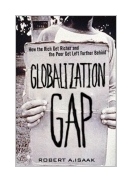|
||
• wydawnictwa polskie
• Zamów informacje o nowościach z wybranego tematu • kontakt
• Cookies na stronie |
GLOBALIZATION GAPISAAK R.wydawnictwo: FT/PH , rok wydania 2005, wydanie Icena netto: Globalization is inevitable but it's also magnifying the gulf between the rich and poor. New extremes of wealth and deprivation are increasingly threatening the stability of the entire global system. The Globalization Gap reveals how globalization is spreading poverty, disease, and the disintegration of traditional cultures. A few "winners" are using their wealth to buffer themselves against these radical transformations. But, in most places, the new wealth generated by globalization is not trickling down. The result? More misery and political upheavals that will endanger us all.
Isaak argues that it doesn't have to be this way, and that the promised benefits of globalization can be gained without the withering unfairness. Isaak presents a realistic blueprint for sharing opportunity and creating sustainable innovation everywhere, showing how a new globalization can give the poor a powerful stake. The Globalization Gap takes on the most crucial challenge of the 21st century: making globalization work for everyone. Features
Table
of Contents I. THE RICH: WHO THEY ARE, HOW THEY WORK, AND WHY THEY SPEED THINGS UP. 3. Who the Rich Are and How They Live. 4. Pyramids of Opportunity. 5. Corporate Wealth and Hedging . 6. The Global Speed Trap: Diversifying to Ward off Losses and Old Age. II. THE POOR: WHO THEY ARE, HOW THEY LIVE, AND WHY THEY ARE DEPENDENT. 7. Why the Poor Are Where They Are. 8. A Passage Through India. 9. Poverty Traps. III. THE RULES. 10. Origins of the Rules. 11. How the Rules Rule the Poor. IV. CRISES AND SOLUTIONS. 12. Global Crises We Will All Face. 13. A Blueprint for Sharing Opportunity. About Author Robert A. Isaak, is Professor of International Management at New York's Pace University. His books include Green Logic and Managing World Economic Change. He has consulted for global enterprises including Siemens, Technicon, and Prudential Intercultural 267 pages
Po otrzymaniu zamówienia poinformujemy, |


